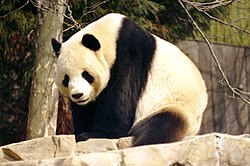This article needs additional citations for verification .(August 2022) |



Animals are multicellular eukaryotic organisms in the biological kingdom Animalia. With few exceptions, animals consume organic material, breathe oxygen, are able to move, reproduce sexually, and grow from a hollow sphere of cells, the blastula, during embryonic development. Over 1.5 million living animal species have been described—of which around 1 million are insects—but it has been estimated there are over 7 million in total. Animals range in size from 8.5 millionths of a metre to 33.6 metres (110 ft) long and have complex interactions with each other and their environments, forming intricate food webs. The study of animals is called zoology.
Contents
- By common name
- By aspect
- By domestication
- By eating behaviour
- By endangered status
- By extinction
- By region
- By individual (real or fictional)
- Real
- Fictional
- By taxonomical classification
- Phyla
- Chordata
- References
Animals may be listed or indexed by many criteria, including taxonomy, status as endangered species, their geographical location, and their portrayal and/or naming in human culture.




